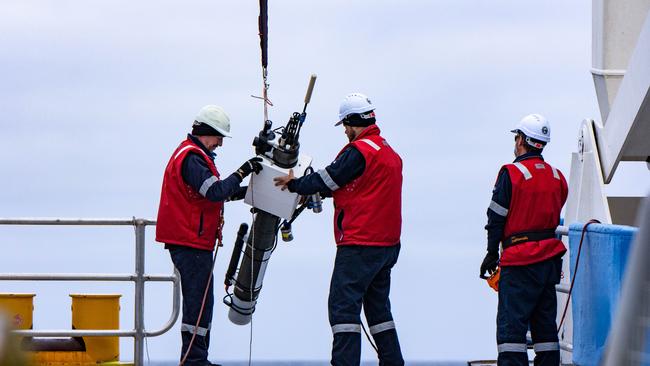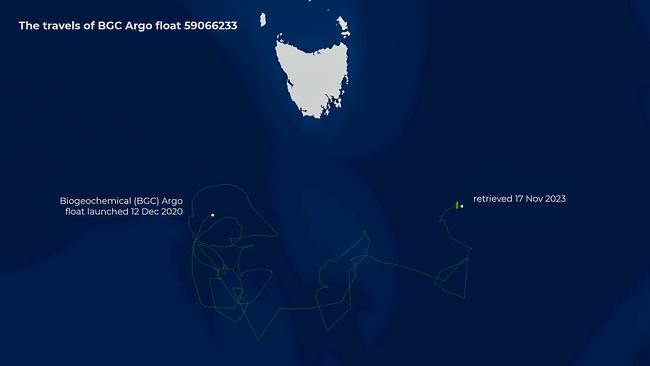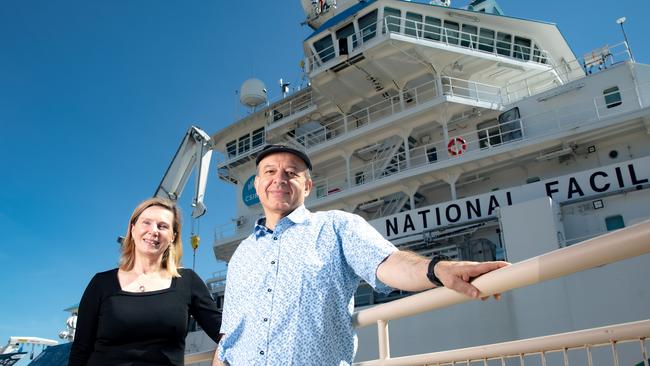CSIRO’s RV Investigator retrieves groundbreaking robotic float from Southern Ocean
The team on-board the RV Investigator have retrieved a one of a kind robotic float that has been measuring and capturing the depths of the Southern Ocean for three years.

Tasmania
Don't miss out on the headlines from Tasmania. Followed categories will be added to My News.
Crucial data from the depths of the Southern Ocean has been retrieved after the team aboard CSIRO’s RV Investigator successfully recovered a robotic float deployed three years ago.
The biogeochemical Argo float, which was deployed in December 2020, was collecting data for scientists to better understand how carbon on the surface ocean reaches the deeper ocean.
“Satellites can only see the surface but they don’t work very well in cloudy conditions and it’s very cloudy in the Southern Ocean,” CSIRO scientist and Integrated Marine Observing System Biogeochemical Argo leader Dr Christina Schallenberg said.

“The float gives us data in any season, any weather conditions and it also gives us this whole depth of the ocean.”
The float changes its density by inflating a bladder which allows it to go between depths. Every 10 days, the float would shift its parking depth of 1000m and sink itself to 2000m to begin collecting measurements with its sensors.
The float would then rise to the surface – taking more measurements along the way – to communicate with a satellite, which would send collected data to scientists. The float would then return to its parking depth to repeat the process.

In the float’s three-year mission, it collected data on temperature, salinity, algal concentration, suspended matter, oxygen, nutrients, light and pH of seawater.
But what makes this Argo float one of its kind is it can capture particles through an underwater visual profiler.
“It’s a high-end camera that takes pictures of all the particles in the water column. Every time the float came up, it told us how many particles and its size in this depth range,” Dr Schallenberg said.
“Now we’ve gotten the float back, we can get the actual pictures of these particles, which will tell us their size, but what they are – faecal pellets, fresh plankton, other detritus – which is crucial for knowing how the sinking of these particles moves carbon from the surface to the deep ocean.”

The Marine National Facility built a new recovery net, which looks like a trampoline, to retrieve the float from on-board RV Investigator, which left Hobart on Wednesday.
“The recovery operation was a tricky dance between wind and currents to manoeuvre the ship into position,” Marine National Facility and CSIRO’s Jason Fazey said.
“Once the float was moving alongside the ship, it took careful co-ordination between the bridge officers and the skilled deck crew to catch the 2m long, 100kg float with a small net.”

CSIRO oceanographer and chief scientist of the research voyage Dr Benoit Legresy said the “rich” data the float contains was “priceless”.
“I’m excited by this recovery because the wider use of autonomous instruments like these floats offers great potential for more breakthrough science from the Southern Ocean,” he said.
Once scientists get the data and images from the float, it will be refurbished with sensors and new batteries to potentially have a second life in the Southern Ocean.




